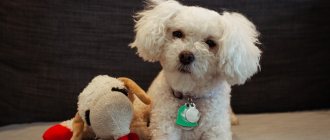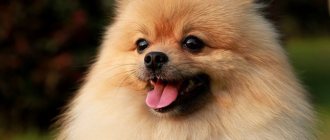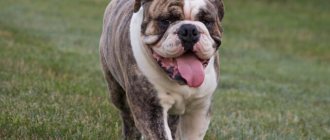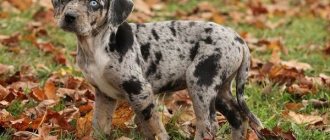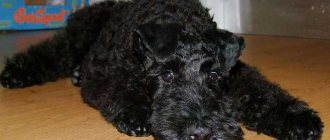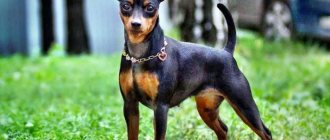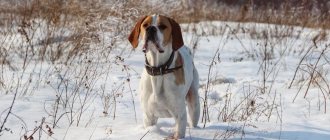These are not just decorative miniature dogs created for soft beds and spa treatments. Dogs actually served on ships, in palace storerooms, and on farms. Brave Bolonkas caught rodents, protected their owners from robbers, and saved them from cold and melancholy. Now breeds from this group constantly appear at exhibitions, in show programs, and participate in circus and theater performances. Animals love attention and human care.
Description and features
The homeland of this beautiful animal is Russia, or rather the Soviet Union. It was bred in the 50s of the 20th century. The Russian lapdog in the photo looks decorative, however, almost all breeds selected here have exclusively working purposes.
Initially, the dog was used to guard and transport cargo on carts. It’s amazing, but the gentle lapdog can even hunt, and does it with joy. She is devoid of bloodthirsty instincts, but the desire to catch prey appears if she needs to get the owner's approval.
For his sake, the dog is ready to do anything, even give his life. Boundless devotion to one person is its basic feature. The Russian lapdog becomes so attached to its owner that it can even die from melancholy if it faces a long separation from him.
Interest in breeding cute ornamental dogs appeared only after the end of World War II. At that time, on the territory of Russia, different miniature breeds of dogs were actively crossed in order to obtain a small, attractive-looking and, at the same time, efficient individual.
In those years, the demand for such animals was enormous. Women showed particular sympathy for them. The beauties of that time were pleased to go out into the world holding a fluffy and cute dog in their arms, radiating tenderness. They were noticed, loved and pampered.
The Russian lapdog is a good companion and friend. It is pleasant to interact with her, she helps to get rid of sadness and other negative emotions. In addition, the animal is very smart. It always understands if its owner is unhappy. But the owner’s joy will certainly make the dog happy and make him more cheerful.
The Russian lapdog becomes very attached to its owner and misses him greatly.
It’s hard to believe, but despite its miniature size, this breed is very hardy and strong. Its representatives can not only relax on upholstered furniture, but also quickly catch up with forest animals, take part in races and other competitions.
Such a pet will certainly brighten everyone's life. He is friendly, cheerful, gentle and loving, at the same time courageous, purposeful and fearless. Family safety is the animal's priority. It will not tolerate the presence of an intruder in the house and will definitely fight back.
Mating
Official mating must take place under the patronage of a nursery . To do this, dog owners sign and fill out a special form indicating the date. Both pets are checked and disinfected. The owner of the dog sets the price. Usually it is equal to one puppy or a percentage of the cost of the dog. If the female does not become pregnant, mating is not paid.
Bolonki become sexually mature at 10 months, but the most favorable period for mating is 2 years. During heat, the girl should show some signs indicating readiness: loosening and softening of the loop, clear discharge and playful behavior.
The female is brought to the male dog’s territory so that the boy feels confident and knows that this act is carried out only in his home . The animals sniff and get to know each other. After which the girl will allow you to do the cage. If there is no lock, there is no need to worry, this does not mean that the female is empty. Repeated fastening is carried out after 48 hours.
Breed standard
This dog is compact, beautiful and very fluffy. Its body is oblong and square. The body posture is high and muscular. The chest moves forward slightly at the moment of movement. There is a slight bulge in the lower back.
The Russian lapdog has a small head and a pronounced muzzle. The nose is small and pigmented. According to the standard, if a dog is born with a light shade of fur, its nose has a similar color.
The dog's bite is correct. Her jaws are tightly closed. The teeth are tiny. The eyes are large and round. Most often, the color of the iris is brown. Eyes that are too protruding are considered a deviation. Also, they should not be planted deep.
The lapdog's ears are set high, have a clear triangular shape, and are narrowed upward. This is her “calling card”. The dog's ears are covered with long hair, which needs to be combed every day.
The animal's thighs are muscular and strong. This allows you to quickly push off from the ground. The limbs are stable and strong. The front ones are shorter than the rear ones. The pads of the feet are dark colored. The tail is rounded, located high on the lower back. Covered with fur along its entire length.
The main visual feature of the Russian lapdog breed is its thick fur. It is so beautiful that it even sparkles in the sun. According to the standard, it should be slightly wavy. Individuals with curly hair are not allowed to take part in competitions and exhibitions.
In addition, the dog has a dense undercoat. Almost any solid color is acceptable, except beige and white. Touching the thick fur of a lapdog is very pleasant. It feels like silk to the touch.
Rarely is a dog of this breed born purely black or brown. Usually, the price of such individuals is much higher. Regardless of the color of the fur, the dog may have light markings on its chest and ears.
How to choose a puppy
- Be responsible when choosing a seller. It would be great if it was a single-breed nursery with a long history and exhibition certificates from the producers, and not an unknown company registered “yesterday”.
- When choosing a RZB puppy of a specific color, be prepared for the fact that the animal may change color with age - most often this happens when the dog’s coat becomes very long.
- Russian colored lapdogs of zonal, as well as red and saddleback colors may have contrasting masks on their faces. This is not a defect, but if you don’t like this feature, keep in mind that as the baby grows up and the decorative hair grows on his head, the mask becomes practically invisible.
- Assess the condition of the tail: if it is not thrown over the back in puppyhood, then even in an adult lap dog its position will not change.
- Do not buy Russian colored lapdogs of extremely miniature size if you plan to travel to exhibitions and breed a pet. Dwarf individuals are just fashion victims who do not fit into the breed standard and do not have the right to be exhibited in the rings.
Character
The Russian lapdog simply cannot help but become everyone's favorite pet. She is so charming that she will melt the ice in the heart of even the most brutal person. She experiences tenderness for every living creature throughout her life. First of all, we recommend that large families get such a dog.
If children live in the house with the dog, you should know that every second, every family member will feel happy vibes. The interaction of a representative of this wonderful breed with small children can be called touching.
He is affectionate and sensitive with them. Under no circumstances will a lap dog harm a person, especially a small one. However, she is capable of feeling resentment. This is a vulnerable animal that needs the reverent attitude of all family members.
The Russian lapdog has a playful character
Rough treatment is unacceptable. Some dogs that have been hurt by people since childhood become overly suspicious and angry, but the lapdog does not. It is hard to bear resentment, but having experienced it once, he will not harbor a grudge. Melancholy and sadness are the emotions that an offended dog of this breed is prone to display.
The house where a Russian lap dog lives will never be calm and quiet. The dog is very playful and cheerful, she is always interested in spending time together with members of the household. She is attracted to chasing stuffed animals and some cat pranks.
For example, the animal will probably enjoy lying on the floor together, loud laughter and belly rubs. It cannot live a day without tactile contact. This is a very gentle and affectionate breed.
Yes, her appearance can be called “toy-like”. But this does not prevent her from being a strong dog capable of protecting her beloved family. Do not forget that she has the genes of guard dog breeds. Of course, the Russian lapdog is too small to neutralize an armed robber, but if she feels threatened, she will attack without hesitation!
The animal barks loudly only if it senses other dogs nearby. It is a mistake to think that this is how he expresses aggression. For dogs, barking is a means of communication. They communicate by making loud noises.
Such a pet can hardly be called uncontrollable and unbalanced. Usually, he grows up obedient. The dog's calm disposition is its main advantage. They often take lap dogs with them on visits, to social evenings, to shops, restaurants, and even to nature. Being in the arms of a familiar person, dogs will not panic and break free. They always rely on their owners, trusting them completely.
Energy and mobility are qualities that complement the list of distinctive features of representatives of this breed. You can take them with you for a run and even for swimming. Spending time with family members makes these animals happier.
It is believed that the Russian lap dog has a sixth sense and well-developed intuition. It accurately determines the current emotional state of a person, adapting to it if necessary. That is, if, in the dog’s opinion, its owner is upset about something, she will not carry him the ball and invite him to play, but will simply come closer and share his sadness with him.
Owner reviews
It is difficult to find negative reviews about this dog breed on the Internet.
Ilya K. Gave his wife her dream for her birthday - a Bichon Frize. I'm delighted with her. Very smart dogs, ready to play day and night. They ride well in the car. By the way, it’s better to always take it with you. Otherwise, he will scream, bark and cry at home. Our girl is already 11 years old, in good health and still as active as a puppy.
Irina O. We promised our child a dog a long time ago. Everyone couldn't decide on the breed. We bought a Russian colored one. I didn’t even know that there was such a thing, but we were visiting and there we saw this miracle. Baby, but very smart. The wool is so nice! My child (9 years old) and I are best friends. He puts up with a lot from his son, but I make sure that they don’t offend each other.
Interesting Facts:
- The snow-white coat of lapdogs is the result of careful inbreeding. Red and black representatives of the breed lived on Melita. But for breeders, white color was a priority, so only white dogs were allowed for selection;
- lap dogs practically do not shed;
- lapdogs are excellent healers. The breed is often used in canistherapy;
- The most expensive Maltese dog cost 15 thousand dollars.
Kinds
There are several types of lap dogs. They are united by several parameters: miniature, friendliness and lush fur. Mostly women like to have such dogs. Let's consider the popular types of lapdogs, except Russian:
- Bichon Frize. The second name of the dog is “little lion”. These are small and very fluffy dogs that resemble stuffed animals. The Bichon Frize is a good decorative breed, perfect for apartment living.
- Havanskaya. This dog was bred by crossing other types from this group. He is small, has a pleasant appearance, very sweet and affectionate.
- Bolognese. The dog's homeland is France. She is considered the most sociable lap dog.
- Coton de Tulear. A very mischievous and nimble dog. He is filled with energy. The homeland of Coton de Tulear is the famous island of Madagascar.
- Maltese. One of the oldest representatives of this group of dogs. The Maltese is very fluffy.
- Levchen. The dog is very similar to a large Persian cat. He is just as graceful and fluffy. They cut it so that it resembles a decorative lion with a lush mane.
Moscow watchdog
From the name of the breed it is clear that it was introduced for the purpose of protecting the territory. She has well-developed powers of observation and a territorial sense. The Moscow Watchdog has a massive body (weight - 40-50 kg), tall stature and thick fur. Outwardly, it resembles a hybrid of a St. Bernard and a Caucasian Shepherd Dog.
The priority task for this dog is to protect the territory where the owner and his family live. The dog is suspicious of people who come to see it, but is not aggressive, but only on condition that the owner himself let them in. No one without his permission will dare to set foot on the land guarded by the Moscow watchdog; she will not allow it.
This is a very noisy dog that can bark at anyone who comes close to its territory. So, she is trying to communicate her watchdog intentions. Despite the willfulness of the breed, it is quite easy to train. But there is no need to teach the Moscow guard, because this is inherent in it by nature.
Care and maintenance
Living in a confined space will make absolutely any dog unhappy. A purebred dog should periodically leave its territory. This is necessary to gain new emotions and impressions.
The Russian lapdog is a classic “indoor” version of a pet. She does not require frequent walks, like, for example, a Chihuahua, and tolerates separation from household members, but not for long.
When leaving the apartment and leaving the dog alone, do not worry about the safety of household items. The lapdog will not spoil your shoes or tear up furniture with pillows. Usually, when left alone in the apartment, she lies down at the front door, waiting for the people dear to her to return. Rest assured, the arrival of a stranger in the house will definitely not be a reason for her to be warmly received.
Of course, if one of the family members is in the apartment at that moment, the animal will not attack the person who comes. This is how a dog’s intellectual potential is revealed. A smart dog always relies on the owner, that is, the arrival of a stranger for him is an event that a person must control.
To make the life of a Russian lap dog comfortable, you should purchase a lot of colorful soft toys for it. Brightly colored rubber animals, such as ducklings, work best. They are easy to find at any pet store.
Now about leaving. The Russian lap dog is unpretentious in this regard. But, she has a long, silky coat that should be brushed daily. We recommend using a metal comb. Some owners cut their dogs' hair in the summer to keep them cool. It makes sense. In this case, there is no need for daily combing.
Important ! If your Russian lap dog takes part in any competition or is shown at an exhibition, its coat requires additional care. We recommend using conditioner for decorative dogs along with shampoo.
Girls' lap dogs often have their hair braided, and I attach various hairpins to the hair. This way they look more attractive, but in this case you will have to comb their fur more often. Additional care points:
- Washing. Remove stains from your dog's eyes with a damp hand.
- Removing dental plaque. Since lap dogs have very small teeth, cleaning them is not easy. But, this must be done at least once a month.
- Grinding claws. Representatives of decorative dog breeds need to file or trim their claws, as they cannot cope with this task on their own.
- Removing sulfur. Every day, dust and dirt accumulate in the ears of animals, which should be removed in a timely manner. Otherwise, severe inflammation occurs.
Beagle
"Beagle"
Beagle dogs originated in medieval England. The royal nobility used them to track deer and roe deer and hunt hares. This breed of small dogs instantly captivates with its remarkable charm, and their charming eyes seem to look straight into your soul, especially if the animal has set the goal of begging you for a treat. These dogs have a short and dense coat, standard height at the withers varies between 33-40 cm and a weight of 9-14 kg. Beagles have an excellent temperament - they are energetic and intelligent, playful, loyal and friendly. Their keen sense of smell can sometimes make walks especially interesting as they try to keep track of every scent they encounter.
Nutrition
The duration and quality of your pet’s service depends on quality nutrition. In order for him to always remain healthy and beautiful, his body must regularly receive beneficial nutrients, from carbohydrates to plant extracts.
A Russian lapdog puppy should eat at least 100-150 grams of lean meat, such as chicken, every day. By the age of six months, its skeleton is formed and weight gain occurs. At this stage, it is important to lay the foundation of his health and immunity. Meat portions should alternate with dairy portions. Every lapdog needs such natural nutrition. In addition to the above, its menu may include:
- Borscht, soup.
- Lean fish.
- Cottage cheese, butter, sour cream.
- Chicken eggs.
- Broccoli, greens.
- Apples, bananas, strawberries.
- Non-acidic berries.
You should not experiment with your pet's menu. If the “wrong” food gets into his stomach, he risks getting sick. List of foods prohibited for lap dogs:
- Semi-finished meat products (for example, dumplings and pasties).
- Mayonnaise.
- Raw potatoes.
- Fatty meat (for example, pork).
- Peppery or salty dishes.
- Pasta.
- Sweets, including cream cakes.
It is better to feed a small lap dog frequently, at least 4 times a day. The number of meals is reduced gradually. An adult dog of this breed's bowl is filled with food twice a day. By the way, you can give your one-year-old pet dry food. But choose only a quality product!
Feeding
It is permissible to feed lapdogs both industrial food (not lower than premium) and natural food. In the second case, vitamin complexes will be needed so that the dog receives everything it needs for health.
Bolonki are gluttons and beggars. You should not follow a lead and feed your pet excessively or with food from the table. Obesity and allergies are faithful companions of the breed.
“Souring” of the eyes and excessive lacrimation are the first signal of flaws in the diet. With proper care, your pet will be with you from 12 to 17 years.
Reproduction and lifespan
On average, this adorable dog lives for 14 years. With good care, its service life is extended to 1-2 years. Healthy, sexually mature and strong-looking Russian lap dogs are allowed to reproduce. The recommended age for breeding them is 2-3 years.
Before breeding animals, the breeder must make sure that they are not related. Otherwise, he will not get healthy puppies. So, mating occurs in the middle of the bitch’s estrus period, on days 3-5. The countdown should be carried out after the appearance of blood discharge.
Russian lapdogs are peace-loving dogs, so they rarely show hostility towards each other when meeting each other. But if the bitch doesn’t like something, she can push the male away. In this case, there is no need to force them on each other. It is better to postpone the mating for a couple of days.
Origin story
The breed is named after the Italian city of Bologna. In the Middle Ages, small dogs were used in aristocratic houses in various European countries. Their owners were noble women who got animals for decoration. This species of quadruped was one of the first to be used for decorative purposes.
Ordinary residents of European countries at that period of history were not interested in keeping such pets. They were interested in the dog’s skills and ability to work. The exact history of the origin of the lapdog is unknown; all types of the breed have their own theories. It is only known that breeding was carried out by breeders who wanted to please the royal and other noble families. Today lapdogs are common in many countries. The price of most varieties is affordable for many who want to have a pet.
Price
Having such a “living toy” at home is a great happiness. But, unfortunately, in Russia you can’t buy it in every city. Therefore, if you want to become the owner of a purebred Russian lap dog, you will have to go to the capital, that is, to Moscow, to get it.
It is in this city that there are 2 kennels where such dogs are professionally bred. There, the buyer will be provided with information about the health status of each puppy and will be helped to choose one. The price of a Russian lap dog from a nursery is 20-25 thousand rubles.
If you want to save money, you can use another method of purchasing - from your own hands. The cost of a puppy of this breed from breeders for 2022 is 8-15 thousand rubles. Individuals painted black or brown are considered rare, so they can be more expensive.
Maltese
Perhaps these are the first Bolonki that existed in the world. Similar dogs were described by Charles Darwin in his works. Images of white little dogs were found on burial slabs from the 8th century BC. And these Bolonki were sailors. The name arose due to an error in the texts. In fact, the animals originated on the island of Meletus near Croatia.
There is a version that the name came from the Latin language. “Malat” is translated as “harbour”, that is, the Maltese is a resident of the harbor.
The animals were noticed by rich people and kings, so Maltese did not have to serve in the navy for long. Mary Stuart herself and Queen Victoria maintained small kennels of lapdogs. The breed has gone through a long selection process to improve the quality of its coat and reduce its size.
In the 1930s, breed clubs grew, a standard was issued, and the breed gained recognition. It is assigned to the Italian canine organization. The lap dogs must be white; beige shades are rarely allowed. The coat without undercoat is straight, soft, silky and shiny.
There are currently two breed standards:
- American (characteristic short muzzle, reduced weight to 3 kg);
- Worldwide (animal weighs 3.5-4 kg, stretched body format, muzzle of medium length).
This is a pampered and spoiled breed, very touchy and selfish, often the dogs are jealous and impatient. Despite this, the animals are loyal and affectionate, non-aggressive, kind and sweet. With proper upbringing, the Maltese will not bark for no reason, play around and spoil things. The average cost of puppies is 15,000-25,000 rubles.
Education and socialization
The Russian lapdog is a sociable and peace-loving dog. She is upset by people's quarrels among themselves, their screams and hysterics. Therefore, it is important that a friendly atmosphere reigns in the apartment in which such a pet lives.
It is useless to teach a decorative dog strict guarding, ferocious hunting and observation. He will not be able to go against his nature. But teaching him circus tricks is quite easy.
Lapdogs are smart dogs, so even a child can handle their training. When you bring a small and cute dog into your home, show him a place where he can sit. When he approaches him, say clearly: “Place!” Repeat this command daily, and then your pet will remember it and will be able to leave the room at any time if circumstances so require.
If your pet tries to bite someone, even during play, do not let him do it. Say loudly: “Ugh!” Every pet dog must know this command, especially those who live in an apartment. Also, don't let her chew on pillows or furniture.
If you didn’t take care of your pet and he still chewed something, you should scold him for it, but don’t even think about using physical force! The Russian lapdog requires a tender and reverent attitude. She shouldn't feel pain. The best punishment for her is verbal.
You can train your dog to fetch a ball. Every time you throw it in front of you, say: “Fetch!” The game should be called “Where is the ball?” Every time you say these words, the mischievous dog will go in search of his favorite toy and bring it to you.
It should be noted that representatives of this breed do not need serious educational work. They are smart, obedient, and not prone to dominance. Such pets are a model of obedience and devotion. But, due to their strong attachment to their family members, they periodically act out when they are left alone at home.
By causing damage to household items, the dog tries to attract the owner’s attention and force him to stay at home next time. If your Russian lapdog is prone to this behavior, we recommend equipping him with a spacious playpen. Leave it there every time you plan to leave the apartment for a while.
Training
Raising a lapdog puppy is a responsible undertaking.
It is necessary to start from the very first day the baby arrives in the house. The main mistake made by owners of lap dogs is forgiveness. The lap dog must clearly understand the “No” command. Otherwise, the white sly one will become uncontrollable. Basic commands need to be taught as early as 2 months. It is better not to experiment with punishments : representatives of the breed react negatively to screams and violence, they can hide in corners and leave piles there. When raising lap dogs, it is better to be patient and actively praise them for successful actions, not forgetting about treats - such motivation will bring much more benefit than punishment: a lap dog is not a service dog after all.
It is better not to expect any special success in obedience from lap dogs - this is not the breed to obey commands without complaint. If the owner does not treat him with something tasty for successfully completing a task, the lapdog is sincerely indignant that he was deceived.
Particular attention should be paid to the “Come to me” command. A strict commanding tone and command is the only way to call a lap dog who is keen on research on a walk.
Professional courses are not what a lap dog needs. If you wish, you can pay attention to performing acrobatic tricks. Dancing and acrobatic performances performed by lap dogs are something! But learning will not be quick. It’s worth spending several months learning one number and preparing lots and lots of delicious food.
Possible diseases and methods of treating them
There are no specific genetic diseases in Russian lap dogs. They are strong, resilient and healthy. To make sure your pet doesn’t get sick, we recommend that you vaccinate him regularly. First, the dog should be registered with an animal clinic.
There he will get a passport, where information about him and its owner will be entered. Secondly, don’t forget about vitamins! Zoological salons and stores sell special immunostimulating complexes for animals.
Advice ! You should not prescribe vitamins to your lapdog on your own. This should be done by the veterinarian examining her. For prevention purposes, we recommend regularly giving your dog medications against parasites: worms, ticks and fleas.
The doctor must write recommendations on their prescription in the dog’s personal passport. Don't forget to take him for a medical examination at least once a year! This will help avoid the development of pathology in his body. The first sign of a sick dog is refusal to eat. In addition, an unhealthy dog exhibits the following symptoms:
- Lethargy, weakness.
- Dry nose.
- Whining.
- The desire to be alone.
If you suspect that your lapdog is sick, we recommend taking her to the doctor.
Nurseries
When choosing a pet, it is not recommended to trust unverified sources. You should contact dog breeding kennels or reputable kennel clubs. By purchasing a dog in specialized places, the buyer is guaranteed to protect himself from purchasing a mixed breed, genetically diseased offspring, or a litter from an emaciated, sick female. When selling titled puppies, the breeder is required to provide a veterinary passport, the mark of the Russian Canine Federation, and a record of age-appropriate vaccinations. To be more confident, you should contact an independent expert. It is allowed to separate the puppy from its mother after two months. The breeding of lapdogs is practiced in almost all major cities. A list of nurseries and breeders, addresses, photographs and reviews can be found on the Internet.
Magyar agar
Also known as the Hungarian Greyhound. The first mention of the breed dates back to the 10th century, when dogs of this species were kept by members of the nobility to chase deer and hares during horse hunts. These are timid, reserved dogs, hardy, capable of long runs.
The height at the withers of females is 61-67 cm, males – 65-70 cm. The dog’s body is noticeably elongated in length, the bones and muscles are highly developed and clearly visible. The head of the Magyar-agar is wedge-shaped, not sharp, and quite voluminous. The ears are large, heavy, pressed to the neck, but can be raised. The coat is short, single-layered, and comes in almost any color except blue, brown, wolf, tan and tricolor.
Advantages
The breed has many advantages. Owners, for the most part, do not even know what negative aspects lap dogs have. In fact, it all depends on upbringing. In general, the Russian Tsvetnaya lapdog breed was bred as an easygoing small decorative dog with a gentle character and lack of aggressiveness. In addition to these positive qualities, you can add the following advantages:
Devotion, love, affection; Playfulness and energy (dogs remain active until old age); Lapdogs love children and people around them, treat other animals well, and even get along easily with cats; Dogs adapt to the rhythm of their owner’s life and sense his mood; Strong build (for a decorative dog, Colored lapdogs are very strong); Bravery and courage (they have protective instincts, they can bark at strangers, protecting their owner); High intelligence and ability to train; Cute original appearance, no shedding; Suitable for apartment living.
Flaws
Among the shortcomings of the breed, one can highlight only intolerance of loneliness. The dog begins to miss its owners and mope. Such pets are ready to literally follow the heels of their household members and accompany them on trips.
They can be quite naughty and spoiled, but this only occurs in the absence of upbringing. The dog's behavior always depends on the family.
Whippet
"Whippet"
According to the American Kennel Club, these small, smooth-coated dogs can reach speeds of 56 km/h and up to 70 km/h in a straight line, making them the fastest animal of their size. The Whippet is an English breed of greyhound occupying a middle position between the Greyhound and Italian Greyhound, which is distinguished not only by its incredible running speed, but also by its graceful physique. Height at the withers ranges from 44 to 51 cm with a weight of 10-13 kg. A friendly, affectionate Whippet will become a family favorite who cannot live without you. Leave your pet alone at home for an hour and the dog will suffer. The graceful Whippet is a rare guest in Russia; if you choose him as a companion, you will not be able to avoid the close attention of passers-by on the streets if such a noble breed follows you nearby.
